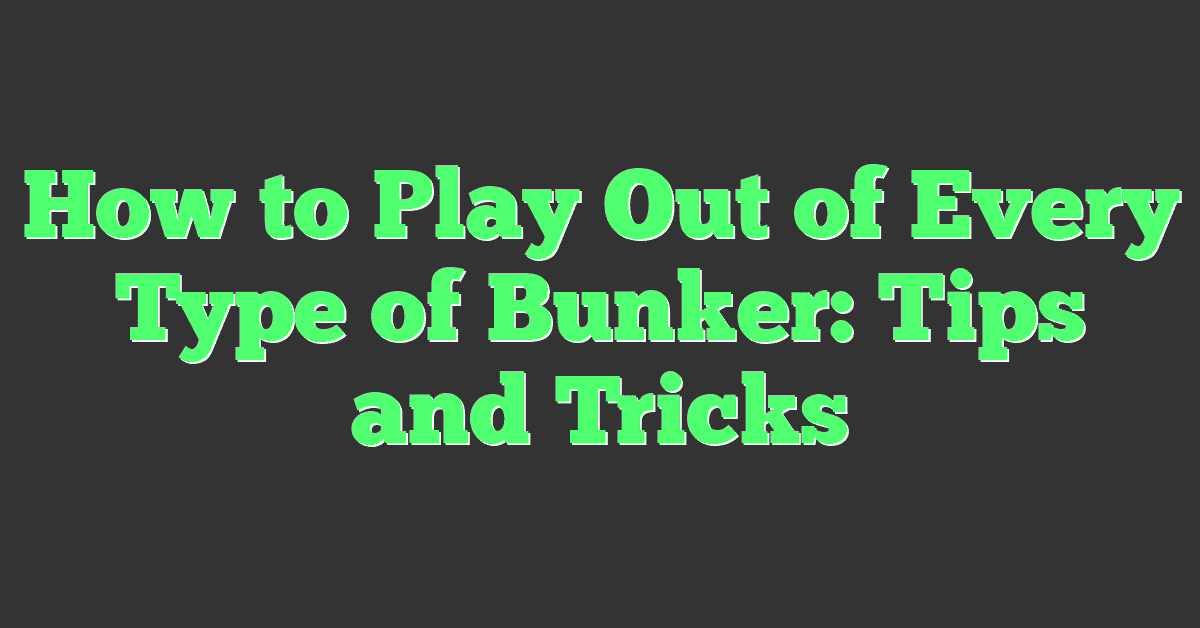If you’ve ever played golf, you’ve probably noticed that golf balls are covered in small, shallow dimples. But have you ever wondered why? The answer lies in the physics of golf ball flight and the mechanics of the golf swing.

When a golf ball is hit, it spins as it travels through the air. The dimples on the surface of the ball create turbulence in the air around it, which reduces the drag on the ball and allows it to travel farther. This phenomenon is known as the Magnus effect, and it’s what gives a golf ball its lift and allows it to stay in the air longer.
But what about divots? Divots are the patches of turf that are displaced when a golfer takes a swing. While they may seem like a nuisance to golf course maintenance crews, they actually serve an important purpose in helping golfers improve their technique. When a divot is taken in front of the ball, it ensures that the golfer is making proper contact with the ball and then turf contact. The low point of the swing should not actually be where the ball is, but rather an inch or two in front of it. By taking a divot in the right place, golfers can ensure that they are making the correct type of contact with the ball to achieve the desired shot.
Key Takeaways
- The dimples on a golf ball create turbulence in the air around it, which reduces the drag on the ball and allows it to travel farther.
- Divots serve an important purpose in helping golfers improve their technique by ensuring proper contact with the ball.
- By taking a divot in the right place, golfers can achieve the desired shot and improve their overall game.
The Basics of Golf Balls and Divots
https://www.youtube.com/watch?v=2B_bkDOnwJY&embed=true
Understanding Golf Ball Design
Golf balls have come a long way since the early days of the sport. Today’s golf balls are designed to maximize distance, accuracy, and control. The design of a golf ball is critical to its performance on the course. The two most important factors that determine a golf ball’s performance are its size and weight.
Golf balls are typically made of a rubber core that is surrounded by a layer of plastic or rubber. The outer layer of the golf ball is covered with dimples. The dimples on a golf ball are not just for decoration. They play a crucial role in the ball’s performance.
According to HowStuffWorks, dimples on a golf ball help create turbulence in the layer of air around the ball which reduces drag and makes the ball fly further. It is widely believed that a golf ball without dimples would fly about half the distance of a golf ball with dimples.
What Are Divots in Golf?
Divots are the patches of turf that are removed from the ground when a golfer takes a shot. Divots are a natural part of the game of golf and are caused by the clubhead hitting the ground during a swing. Divots can be a nuisance for golf course maintenance crews, but they are an important part of the game.
Divots can be classified into two categories: fairway divots and approach divots. Fairway divots are the patches of turf that are removed from the fairway when a golfer takes a shot. Approach divots are the patches of turf that are removed from the ground when a golfer takes a shot from the rough or around the green.
Divots are important because they can affect the way a golf ball travels. When a golf ball lands in a divot, it can cause the ball to spin or bounce in an unpredictable way. Golfers must learn how to adjust their shots to compensate for divots on the course.
In conclusion, understanding the basics of golf ball design and divots is critical to improving your game. By understanding how golf balls are designed and how divots can affect your shots, you can make better decisions on the course and improve your overall performance.
Physics of Golf Ball Flight
https://www.youtube.com/watch?v=fcjaxC-e8oY&embed=true
Golf is a game of precision, and the flight of the ball is a critical factor in determining success. Understanding the physics of golf ball flight can help you improve your game and hit the ball farther and more accurately.
Aerodynamics and Dimples
One of the most important factors that determine the flight of a golf ball is its aerodynamics. The shape of the ball and the air resistance it encounters while in flight are crucial to how far and how accurately it travels. The dimples on a golf ball are not just for decoration; they play a vital role in the ball’s aerodynamics.
According to a Scientific American article, the dimples on a golf ball affect its flight by changing the lift and drag forces acting on it. The dimples create a thin layer of air that clings to the ball’s surface, reducing the drag and allowing the ball to fly farther. The number, size, and depth of the dimples on a golf ball are carefully calculated to ensure optimal aerodynamics.
The Effect of Spin on Ball Flight
The spin of a golf ball is another critical factor that affects its flight. The amount of spin on the ball can determine its trajectory and how far it travels. Spin is created by the friction between the clubface and the ball upon impact.
As mentioned in Stanford article, the grooves on the club head have the greatest impact on the amount of spin that can be generated on the golf ball. The grooves create friction and allow the golfer to impart a spin on the ball, which can affect its flight. A backspin on the ball can cause it to rise higher and travel farther, while a sidespin can cause it to curve in the air.
In conclusion, understanding the physics of golf ball flight can help you improve your game and hit the ball farther and more accurately. The dimples on a golf ball reduce drag and allow the ball to fly farther, while the spin on the ball can affect its trajectory and distance. By mastering these concepts, you can become a better golfer and enjoy the game even more.
Golf Swing Mechanics
https://www.youtube.com/watch?v=N1Yd_CXkdi4&embed=true
To understand why golf balls have divots, you need to understand the mechanics of a golf swing. A golf swing is a complex motion that involves multiple body parts working together in harmony to produce a powerful and accurate shot.

The Role of Swing Path
« Why Do Golf Balls Have Dents? Exploring the Science Behind Golf Ball Design
What Golf Ball to Use for High Swing Speed: Tips and Recommendations »
The swing path is the direction that the clubhead travels during the swing. It is important to have a consistent swing path because it determines the initial direction of the ball. If the swing path is too far to the left or right, it can cause the ball to slice or hook.
To achieve a proper swing path, you need to start with a good setup position. Your feet should be shoulder-width apart, and your knees should be slightly bent. Your weight should be evenly distributed between your feet, and your shoulders should be square to the target.
Angle of Attack and Contact
The angle of attack is the angle at which the clubhead strikes the ball. It is important to have the correct angle of attack because it affects the trajectory and spin of the ball.
When you make contact with the ball, you want to hit down on it slightly to create a divot. This ensures that you are making ball and then turf contact. The low point of your swing should not actually be where the ball is, but rather an inch or two in front of it. This is why divots are important in golf.
To achieve the correct angle of attack, you need to make sure that your hands are ahead of the ball at impact. This will help you hit down on the ball and create a divot.

In summary, the mechanics of a golf swing are complex, but understanding the role of swing path and angle of attack can help you achieve better ball striking and control. Creating a divot is an important part of hitting a good shot, so make sure that you are hitting down on the ball and creating a divot in front of it.
Types of Shots and Their Divots
https://www.youtube.com/watch?v=P0ypo0eoJR8&embed=true
When you hit a golf ball, the ball takes off into the air and flies towards your target. However, the way the ball flies is affected by the type of shot you hit and the divot pattern it creates on the ground. Here are some examples of different types of shots and their corresponding divot patterns:
Iron Shots and Divot Patterns
Iron shots are typically used for shorter distances and require a more precise swing. When you hit an iron shot, you want to hit down on the ball and take a divot after impact. The divot pattern for an iron shot should be a small, shallow divot that is about the size of a dollar bill. This divot pattern helps to create backspin on the ball, which allows it to stop quickly on the green.
If your divot is too deep or too wide, it means you are hitting too far behind the ball. This can cause the ball to fly too high and too short, and it can also cause you to lose control of the shot. On the other hand, if your divot is too shallow or non-existent, it means you are not hitting down on the ball enough. This can cause the ball to fly too low and too far, and it can also cause you to lose distance on the shot.

Driver Shots and Their Impact
Driver shots are typically used for longer distances and require a more powerful swing. When you hit a driver shot, you want to hit up on the ball and take a divot that is shallow or non-existent. The divot pattern for a driver shot should be a small, thin divot that is about the size of a credit card. This divot pattern helps to create less spin on the ball, which allows it to travel farther through the air.
If your divot is too deep or too wide when hitting a driver shot, it means you are hitting too far behind the ball. This can cause the ball to fly too high and too short, and it can also cause you to lose control of the shot. On the other hand, if your divot is too shallow or non-existent, it means you are not hitting up on the ball enough. This can cause the ball to fly too low and too far, and it can also cause you to lose distance on the shot.
In conclusion, understanding the divot patterns for different types of shots can help you improve your golf game. By paying attention to the size and shape of your divots, you can adjust your swing to create the desired ball flight and spin.
Golf Course Maintenance
https://www.youtube.com/watch?v=U08fjwTy640&embed=true
Maintaining a golf course is not an easy task, and it requires a lot of effort to keep the course in good condition. One of the crucial aspects of golf course maintenance is repairing divots. In this section, we will discuss how to repair divots on the green and fairway divot etiquette.
Repairing Divots on the Green
When you hit a shot onto the green, it can leave a ball mark or divot. Repairing these divots is essential to keep the green in good condition for other golfers. To repair a divot, use a divot repair tool or tee to lift the turf around the divot and gently push it back into place. You can also add some sand or seed mix to the divot to help it heal faster.
Remember, repairing divots is not just a courtesy, it is also a rule of golf. According to Rule 13-2, if your ball lands in a repaired divot and your shot is affected, you are entitled to free relief.
Fairway Divot Etiquette
Divots on the fairway can be equally damaging to the course. To minimize the damage, it is essential to practice fairway divot etiquette. When taking a divot, try to replace it immediately, or fill it with sand and seed mix. If you are playing with a cart, avoid driving over the divots, as this can cause more damage to the turf.
Remember, repairing divots is not just a responsibility of the golf course staff. It is also the responsibility of every golfer to ensure that the course remains in good condition for future players.
In conclusion, maintaining a golf course is a team effort, and repairing divots is an essential part of it. By following these simple steps, you can help keep the course in good condition and ensure that everyone can enjoy their game.

Improving Your Golf Technique
If you want to improve your golf game, you need to work on your technique. Here are a few tips to help you adjust your swing and stance to create better divots:
Adjusting Swing for Better Divots
Your swing is one of the most important aspects of your golf game. If you want to create better divots, you need to adjust your swing. One way to do this is to focus on hitting down on the ball. This will help you create a divot that is deep enough to indicate proper ball contact, but not so deep that it ruins the fairway. To hit down on the ball, you need to shift your weight from your back foot to your front foot during the downswing. This will promote a descending blow on the ball and help you create a divot that is just right.
Another way to adjust your swing for better divots is to focus on sweeping the ball off the turf instead of taking deep divots. This will ensure clean contact with the ball and maximize your distance. To do this, engage a shallow angle of attack. This means that you should hit the ball at a shallower angle than you would with a normal swing.
Stance and Ball Position
Your stance and ball position are also important when it comes to creating good divots. If you want to create a divot that is deep enough to indicate proper ball contact, you need to position the ball correctly in your stance. This means that you should position the ball slightly ahead of center in your stance. This will help you hit down on the ball and create a divot that is just right.
Your stance is also important when it comes to creating good divots. You need to maintain balance and weight transfer throughout your swing. This means that you should shift your weight smoothly from your back foot to your front foot during the downswing. This will promote a descending blow on the ball and help you create a divot that is just right.

By adjusting your swing and stance, you can create better divots and improve your golf game. Remember to focus on hitting down on the ball and sweeping the ball off the turf. Position the ball correctly in your stance and maintain balance and weight transfer throughout your swing. With a little practice, you’ll be creating perfect divots in no time!
Golf Equipment and Accessories
When it comes to playing golf, having the right equipment and accessories can make all the difference in your game. From choosing the right irons and wedges to having a divot tool on hand, the equipment you use can help you improve your swing and overall performance on the course.
Choosing the Right Irons and Wedges
One of the most important pieces of equipment in your golf bag are your irons and wedges. These clubs are used for a variety of shots, from short chips to long approach shots. When choosing your irons and wedges, it’s important to consider your skill level and playing style.
For beginners, it’s recommended to start with a set of cavity back irons, which are more forgiving and easier to hit. As you improve, you can move on to more advanced irons and wedges that offer greater control and precision.
The Importance of a Divot Tool
Another essential accessory for any golfer is a divot tool. Divot tools are used to repair the marks left on the green by golf balls. These marks can cause damage to the grass and affect the roll of the ball, so it’s important to repair them as soon as possible.

Using a divot tool is easy – simply insert the prongs into the ground around the mark and gently push the grass back into place. This will help the grass to heal and prevent any further damage to the green.
In addition to repairing divots, a divot tool can also be used to clean your clubs and remove debris from your golf shoes. This can help to improve your grip and prevent slips and falls on the course.
Overall, having the right equipment and accessories can help you to play your best game of golf. Whether you’re a beginner or an experienced player, investing in quality irons and wedges, and carrying a divot tool, can help you to improve your performance and enjoy the game even more.
Common Questions About Divots
If you’re new to golf or have never given much thought to the divots on the course, you may have some questions. Here are some common questions and answers about divots:
FAQ on Divot Size and Depth
Q: How big should a divot be?
A: The size of a divot can vary depending on the club used and the swing of the golfer. In general, a divot should be about the size of a dollar bill. For shorter clubs, such as wedges, the divot may be a bit larger.
Q: How deep should a divot be?
A: The depth of a divot should be about 1-2 inches. Going too deep can damage the turf, while not going deep enough can indicate a poor swing.
Q: What are divot tools?
A: Divot tools are small devices used to repair divots on the course. They are designed to help golfers fix their own divots and keep the course in good condition.

Solving Divot-Related Problems
Q: What should I do if I take a divot on the course?
A: After taking a divot, be sure to use a divot tool to repair the damage. This helps keep the course in good condition for all golfers.
Q: How can I prevent taking too many divots on the course?
A: One way to prevent taking too many divots is to work on your swing technique. A good swing will result in a clean hit on the ball, which will reduce the number of divots you take. Additionally, using the right club for the shot can also help reduce divots.
Q: What should I do if I notice someone else not repairing their divots?

A: If you notice someone not repairing their divots, kindly remind them of the importance of keeping the course in good condition for everyone.
Golf Strategy and Course Management
Using Divots to Improve Strategy
Divots can be used to your advantage when it comes to strategy. By analyzing the divots on the course, you can determine the best placement for your shots. For example, if you notice that the divots are concentrated on the left side of the fairway, it may be best to aim for the right side to avoid hitting into a divot. Additionally, examining the divots left by other golfers can give you an idea of which clubs and shots work best on a particular hole.
Playing Conditions and Divot Management
Playing conditions can greatly affect the divots on the course. Wet conditions can make divots deeper and harder to fill, while dry conditions can make divots shallower and easier to repair. It is important to manage divots properly to maintain the course and ensure fair play for all golfers. Some courses require filling in divots with sand or seed mixtures, while others may have designated areas for divot repair. Always follow the course’s guidelines for divot management to keep the course in good condition for everyone.
When it comes to your own divots, it is important to take responsibility for repairing them. Not only is it good etiquette, but it can also improve your game. Filling in your divots can help maintain the course’s playing surface and prevent future divots from forming. It can also help you determine the quality of your shots and make adjustments to your swing if necessary.
Shots and Irons
Divots are often associated with iron shots, as they are more likely to create a divot than other clubs. However, divots can also be created with other shots such as pitches, chips, and even putts. It is important to pay attention to the divots created by all of your shots to improve your game and course management.

In conclusion, divots play an important role in golf strategy and course management. By using divots to your advantage, managing them properly, and paying attention to the divots created by all of your shots, you can improve your game and maintain the course for everyone to enjoy.
Advanced Golf Techniques
If you’re looking to take your golf game to the next level, mastering advanced techniques is a must. In this section, we’ll cover two important techniques that can help you recover from difficult situations and improve your precision and control with iron shots.
Mastering the Art of Recovery Shots
Recovery shots can be a lifesaver when you find yourself in a difficult situation on the golf course. Whether you’re in a bunker, behind a tree, or in thick rough, knowing how to execute a successful recovery shot can help you save strokes and keep your scorecard in check.
To master recovery shots, you’ll need to focus on technique, precision, and control. First, assess the situation and choose the club that will give you the best chance of getting out of trouble. Then, focus on your setup and aim to make solid contact with the ball.
One key to successful recovery shots is to keep your head down and your eyes on the ball throughout the swing. This will help you maintain your focus and ensure that you make clean contact with the ball.
Precision and Control with Irons
Iron shots require a high level of precision and control to be successful. To improve your iron play, focus on your setup and alignment, as well as your swing mechanics.
Start by choosing the right club for the shot at hand. Then, take your stance and aim the clubface at your target. Keep your feet shoulder-width apart and your weight evenly distributed between your feet.
As you swing, focus on making a smooth, controlled motion. Keep your wrists firm and your arms extended to maintain a consistent swing plane. Finally, follow through with your swing and hold your finish to ensure that you make solid contact with the ball.
By mastering these advanced techniques, you’ll be well on your way to taking your golf game to the next level. With practice and dedication, you can become a skilled and confident golfer, ready to take on any challenge that comes your way.










